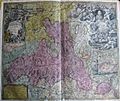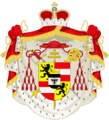Archbishopric of Salzburg facts for kids
Quick facts for kids
Prince-Archbishopric of Salzburg
Fürst-Erzbistum Salzburg
|
|||||||
|---|---|---|---|---|---|---|---|
| 1278–1803 | |||||||
| Status | State of the Holy Roman Empire | ||||||
| Capital | Salzburg | ||||||
| Government | Theocracy | ||||||
| Historical era | Middle Ages | ||||||
|
• Bishopric founded
|
ca 543 | ||||||
|
• Raised to archbishopric
|
798 1278 | ||||||
|
• Gained territory, becoming
prince-archbishopric |
1278 |
||||||
|
• Joined Bavarian Circle
|
1500 | ||||||
|
• Joined Council of Princes
|
1793 | ||||||
|
• Raised to electorate
|
1803 | ||||||
|
• Mediatised to Grand Duchy
|
1803 1803 | ||||||
|
|||||||
|
Electoral Grand Duchy of Salzburg
Kurgroßherzogtum Salzburg
|
|||||||||
|---|---|---|---|---|---|---|---|---|---|
| 1803–1805 | |||||||||
| Status | State of the Holy Roman Empire | ||||||||
| Capital | Salzburg | ||||||||
| Government | Principality | ||||||||
| Historical era | Late Middle Ages | ||||||||
| March 21 1801 |
|||||||||
|
• Established
|
1803 | ||||||||
|
• Mediatised to Austria
|
1805 | ||||||||
| June 9 1815 | |||||||||
|
|||||||||
The Archbishopric of Salzburg was a special state within the Holy Roman Empire. It was ruled by the Archbishop of Salzburg, who was also a "Prince-Bishop." This meant the archbishop had two important jobs: he was a leader of the church (ecclesiastical powers) and also a political ruler of the land (princely powers).
The Archbishopric of Salzburg was roughly the same size as the modern state of Salzburg in Austria. One of the most famous archbishops was Hieronymus von Colloredo. He was the last to rule as a prince and was an early supporter of the famous composer Wolfgang Amadeus Mozart.
Contents
History of Salzburg's Rulers
Early Church Leaders (4th century–c. 482)
Around the year 450, a book was written about the life of St Severinus of Noricum. This book mentioned that Salzburg had two churches and a monastery. St. Maximus is the only known abbot-bishop from this time. Sadly, Salzburg was destroyed around 482, not long after St. Maximus was killed.
The Bishopric Returns (c. 543/698–798)
Later, St. Rupert returned to Salzburg to help rebuild the churches. He found the city in ruins, covered in brambles. Historians aren't sure if he arrived around 543 during the time of Theodo I or closer to 698, when Bavaria was taken over by the Franks.
It wasn't until after 700 that Christian life really started to grow again in the area. The main monastery was named after St. Peter. Rupert's niece, Ehrentrudis, also started a nunnery (a place for nuns) at Nonnberg.
Salzburg Becomes an Archbishopric (798–1060)
Arno, who became archbishop, was highly respected by the Frankish king Charlemagne. Charlemagne asked Arno to help spread Christianity in the land between the Danube, Raab, and Drave Rivers. This area had recently been taken from the Avars. Many monasteries were built, and the entire region of Carinthia slowly became Christian.
While Arno was in Rome in 798, Pope Leo III made him an Archbishop. This meant he was in charge of other bishops in Bavaria. When there was a disagreement about the church's border between Salzburg and Aquileia, Charlemagne decided the Drave River would be the boundary. Arno also started copying 150 books from Charlemagne's court. This was the beginning of Austria's first library!
Challenges for the Archbishops (1060–1213)
The first archbishop during this time was Gebhard. He supported the Pope during a big disagreement called the Investiture Controversy. Because of this, Gebhard was sent away for nine years. He was allowed to return just before he died and was buried in Admont. His replacement, Thimo, was put in prison for five years and died a terrible death in 1102.
After King Henry IV gave up his power, Conrad I of Abensberg was chosen as Archbishop. Conrad lived away from Salzburg until an agreement called the Calistine Concordat was made in 1122.
The Archbishops again sided with the Pope during arguments with the Hohenstaufen family. Archbishop Eberard I ruled peacefully. However, his successor, Conrad II, angered the Emperor and died in 1168 while trying to hide. Conrad III became Archbishop of Salzburg in 1177 after a meeting in Venice, where supporters of both the Pope and Emperor were removed from power.
Salzburg as a Prince-Bishopric (1213–1803)
In 1213, Archbishop Eberard II was made a prince of the Empire. This gave him more political power. He also created three new church areas: Chiemsee (1216), Seckau (1218), and Lavant (1225). In 1245, Eberard was removed from the church (excommunicated) because he refused to announce a decision to remove the emperor. He died suddenly the next year.
During a time of confusion in Germany, Salzburg also faced problems. Philip of Carinthia became ruler of Salzburg but refused to become a priest. This meant he couldn't be the Archbishop, so he was removed by Ulrich, the Bishop of Seckau.
King Rudolph I of the Habsburg family had disagreements with the archbishops. After Abbot Henry of Admont died, the archbishops and Habsburgs made peace in 1297. The people and archbishops of Salzburg remained loyal to the Habsburgs in their fights against the Wittelsbachs.
During a difficult time called the Black Death in 1347, some people unfairly blamed the Jewish community, leading to their expulsion from Salzburg for a while. Later, Jewish people were allowed to return but were forced to wear special hats. The Renaissance, a time of great art and music in Europe, didn't have as much impact in Salzburg. This was because the archbishops weren't always strong rulers, and conditions in the empire were difficult under Frederick IV.
Things were especially bad during the rule of Bernard II of Rohr. The country was struggling, local leaders were unfairly raising taxes, and the Turks were attacking nearby areas. In 1473, Bernard called the first local parliament (called a provincial diet) in the archbishopric's history. He eventually gave up his position.
It was Leonard of Keutschach (who ruled from 1495–1519) who finally improved the situation. He had all the mayors and town council members (who were charging unfair taxes) arrested at the same time and put in the castle. His last years were spent in a tough struggle against Matthäus Lang of Wellenburg, the Bishop of Gurk, who became his successor in 1519.
Archbishop Paris of Lodron helped Salzburg stay peaceful and prosperous during the Thirty Years' War, which devastated much of Germany. During the rule of Leopold Anthony of Firmian, Protestants became more active. He invited the Jesuits (a Catholic religious order) to Salzburg and asked for help from the emperor. Eventually, he ordered Protestants to change their beliefs or leave. About 30,000 people left and settled in places like Württemberg, Hanover, East Prussia, and even a few in Georgia in the United States of America.
The last Prince-Archbishop, Hieronymus von Colloredo, is perhaps best known for supporting Mozart. However, his changes to the church and education made him unpopular with the people.
Salzburg in Modern Times (1803–present)
In 1803, Salzburg stopped being controlled by the church and became a secular state, known as the Electorate of Salzburg. The former Grand Duke Ferdinand III of Tuscany (who was the brother of Emperor Francis II) was made the new ruler.
In 1805, Salzburg became part of Austria, and in 1809, it became part of Bavaria. The Bavarians closed the University of Salzburg, stopped monasteries from accepting new monks, and banned religious pilgrimages and processions. The Congress of Vienna returned Salzburg to Austrian control in 1814.
Bishops of Salzburg
These are the early church leaders of Salzburg.
Abbot-Bishops of Iuvavum c. 300s–c. 482
- St. Maximus of Salzburg d. 476
Abandoned after c. 482
Bishops of Iuvavum (from 755, Salzburg)
- St. Ruprecht c. 543–? or c. 698–c. 718
- Vitalis
- Erkenfried
- Ansologus
- Ottokar
- Flobrigis
- Johann I
- St. Virgilius c. 745 or c. 767–c. 784
Archbishops of Salzburg
These are the Archbishops who led Salzburg.
Archbishops of Salzburg, 798–1213
- Arno 784–821
- Adalram 821–836
- Leutram 836–859
- Adalwin 859–873
- Adalbert I 873
- Dietmar I 873–907
- Pilgrim I 907–923
- Adalbert II 923–935
- Egilholf 935–939
- Herhold 939–958
- Friedrich I 958–991
- Hartwig 991–1023
- Günther 1024–1025
- Dietmar II 1025–1041
- Baldwin 1041–1060
- Gebhard 1060–1088
- Thiemo 1090–1101
- Konrad I von Abensberg 1106–1147
- Eberhard I von Hilpolstein-Biburg 1147–1164
- Konrad II of Austria 1164–1168
- Adalbert III of Bohemia 1168–1177
- Conrad III 1177–1183
- Adalbert III of Bohemia (restored) 1183–1200
Prince-Archbishops of Salzburg, 1213–1803
These Archbishops also held political power as princes.
- Eberhard II von Truchsees 1200–1246
- Bernhard I von Ziegenhain 1247
- Philipp of Carinthia 1247–1256
- Ulrich von Sekau 1256–1265
- Ladislas of Silesia-Liegnitz 1265–1270
- Friedrich II von Walchen 1270–1284
- Rudolf von Hoheneck 1284–1290
- Konrad IV von Breitenfurt 1291–1312
- Weichard von Pollheim 1312–1315
- Friedrich III von Liebnitz 1315–1338
- Heinrich Pyrnbrunner 1338–1343
- Ordulf von Wiesseneck 1343–1365
- Pilgrim II von Pucheim 1365–1396
- Gregor Schenk von Osterwitz 1396–1403
- Eberhard III von Neuhaus 1403–1427
- Eberhard IV von Starhemberg 1427–1429
- Johann II von Reichensperg 1429–1441
- Friedrich IV Truchsees von Emmerberg 1441–1452
- Sigismund I von Volkersdorf 1452–1461
- Burchard von Weissbruch 1461–1466
- Bernhard II von Rohr 1466–1482
- Bernhard III Peckenschlager 1482–1489
- Friedrich V von Schallenburg 1489–1494
- Sigismund II 1494–1495
- Leonhard von Keutschach 1495–1519
- Matthäus Lang von Wellenburg 1519–1540
- Ernest of Bavaria 1540–1554
- Michael von Khuenburg 1554–1560
- Johann Jakob Khun von Bellasy 1560–1586
- Georg von Khuenburg 1586–1587
- Wolfgang Dietrich von Raitenau 1587–1612
- Marcus Sittich von Hohenems 1612–1619
- Paris von Lodron 1619–1653
- Guidobald von Thun 1654–1668
- Maximilian Gandalf von Khuenburg 1668–1687
- Johann Ernst von Thun 1687–1709
- Franz Anton von Harrach 1709–1727
- Leopold Anton von Firmian 1727–1744
- Jakob Ernst von Liechtenstein-Castelcorno 1744–1747
- Adnreas Jakob von Dietrichstein 1747–1753
- Sigismund III von Schrattenbach 1753–1771
- Hieronymus von Colloredo 1772–1812 (last prince-archbishop, lost temporal power in 1803 after secularization)
Duchy of Salzburg 1803–1805
The Duchy of Salzburg was created in 1803, but it was taken over by Austria in 1805. The Duke of Salzburg then moved to the Grand Duchy of Würzburg.
- Ferdinand 1803–1805
Modern Archbishops of Salzburg 1803–present
These are the Archbishops of Salzburg since 1803, after it stopped being a political state.
- Sigmund Christoph, Graf von Zeil und Trauchburg 1812–1814
- Augustin Johann Joseph Gruber 1823–1835
- Friedrich Johann Joseph Cölestin, Fürst zu Schwarzenberg 1835–1849
- Maximilian Joseph von Tarnóczy 1850–1876
- Franz de Paula Albert Eder 1876–1890
- Johann Evangelist Haller 1890–1900
- Johannes Baptist Katschthaler 1900–1914
- Balthasar Kaltner 1914–1918
- Ignaz Rieder 1918–1934
- Sigismund Waitz 1934–1941
- Andreas Rohracher 1943–1969
- Eduard Macheiner 1969–1972
- Karl Berg 1972–1988
- Georg Eder 1988–2002
- Alois Kothgasser 2002–present
Suffragan Dioceses
These are other church areas that are under the Archbishop of Salzburg's authority:
- Feldkirch
- Graz–Seckau
- Gurk
- Innsbruck
Images for kids
-
The coat of arms of Hieronymus von Colloredo as Prince-Archbishop of Salzburg. It shows symbols of both his princely and church roles.
See also
 In Spanish: Principado-arzobispado de Salzburgo para niños
In Spanish: Principado-arzobispado de Salzburgo para niños






